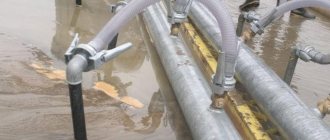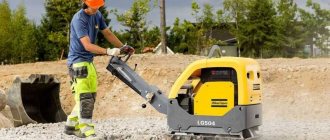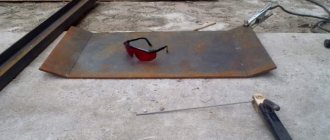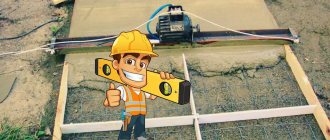Compaction of soil and other bulk materials is an event that constantly accompanies various construction works. Previously, compaction was done manually, but now the vibratory compaction method is used using vibrating plates. Manufacturers offer a wide selection of equipment of this type, equipped with diesel, gasoline or electric engines. When starting to operate the equipment, in order to achieve the result of the required quality, it should be taken into account that the compaction of different materials has its own characteristics. In order for the sealing mechanism to last a long time, it must be operated correctly. At the same time, following safety precautions will help avoid injury.
How to compact crushed stone: methods and compaction technology
A mandatory operation when laying preparatory layers of crushed stone is their compaction.
The process allows you to increase the strength of the crushed stone base and its ability to withstand static and dynamic loads. Tamping can be done manually and mechanized. Crushed stone is a popular building material used in the production of concrete mixtures and for filling the bases of foundations and roads. Since crushed stone grains obtained by crushing rocks have an arbitrary shape, voids form between them, which reduce the strength of the base. A mandatory operation when laying preparatory layers of crushed stone is their compaction, which can be done by manual and mechanized methods. After compaction, the mobility of the grains is lost, the size of the air voids is reduced, and, consequently, the strength of the crushed stone base and its ability to withstand static and dynamic loads increases. The exception is when working on rocky soils. In this case, crushed stone is poured onto the ground and carefully leveled.
Operating principle
Structurally, a vibrating plate consists of a group of components: a supporting part, a main body (which creates vibration), a motor with different types of power, and controls. The lower part of the device, which is in contact with the surface of the earth, is the sole or slab. Its function is to create pressure on the soil and increase its density through vibration.
Important
The greater the mass and dimensions of the base, the higher the efficiency of the vibrating plate. To improve the characteristics of the sole, thick metal of 8 mm or more is used.
Most often, a steel or cast iron sole is used, reinforced by creating a ribbed surface. In addition, the base of the vibrating plate is used to fix the drive and other mechanisms.
The support part has curved edges at the front and back, which simplifies the movement of equipment and prevents the top layer of earth or building materials from being caught. When compacting tiles, a rubber or polyurethane gasket is used to prevent mechanical damage. As a rule, it comes included.
To create vibration, a so-called eccentric/imbalance shaft is used. It receives vibrations from the motor through a centrifugal clutch and is then transmitted to the base. As a result, the treated area experiences pressure from the weight of the product and additionally takes on strong vibrations. Depending on the model, vibration frequency and force may vary.
The vibrator is large in size, because the efficiency of the equipment directly depends on this. It can be with one or two shafts. The first is used for straight sections, and the second is distinguished by its ability to move forward and backward.
How to compact crushed stone manually without using a vibrating plate
Manual compaction is important when carrying out small volumes of repair and construction work. To perform this, various devices are used:
- Horizontal bars that serve as handles are nailed to a wooden beam with a cross-section of 100x100 mm (or 150x150 mm) from above. Its lower part is covered with steel sheet. Such a device is lifted up and sharply lowered onto the crushed stone surface. Due to the small contact area between the device and the crushed stone layer, the work progresses slowly.
- A metal head is attached to the bottom of the beam with a cross-section of 100x100 mm. This is a more effective option compared to the tool described above.
- A metal tool designed for compacting crushed stone with your own hands is durable and effective - a stand and a base welded together. But it is difficult for them to work, since metal, unlike wood, does not dampen vibrations. In this case, special vibration-damping gloves come to the rescue.
Another way to compact crushed stone on the site yourself is to use a passenger car:
- A crushed stone layer is poured onto the site and carefully leveled.
- By car they move around the site in different directions until the crushed stone base is evenly compacted.
- If shallow ruts have formed in some places, they are covered with crushed stone, and then compaction of the site by car is continued.
Compacting crushed stone with a vibrating plate
Vibrating plates are quite productive, compact and mobile equipment with which you can compact large areas. Compacting crushed stone with a vibrating plate is carried out by transmitting shock vibrations to the crushed stone layer. Based on the engine type, the following types of this equipment are distinguished:
- Electrical. Such models provide low noise levels and no exhaust gases, so they can be used even indoors. The limitation on their use is the need for a power source.
- Gasoline. This is autonomous equipment, more productive, heavier and more expensive compared to electric models.
- Diesel. Powerful diesel units provide high performance, have a significant service life and the ability to work for a long time without interruption.
By weight, vibrating plates are light - up to 75 kg, medium - up to 200 kg, medium-heavy - up to 400 kg. Depending on the number of directions of movement, the equipment can be single-pass, capable of moving only in one direction, and reverse, which can move forward and backward.
Ease of use of the vibrating plate
An important criterion is the convenience of the vibrating plate, and ease of use, transportation and maintenance.
We list some features of vibrating plates that affect the comfort of working with them:
Transport wheels. When transporting light and medium-class vibrating plates (up to 200 kg), you can do without the use of loading equipment if the vibrating plate is equipped with transport wheels. This factor significantly reduces delivery costs and increases comfort when moving the slab around the site. Folding handle. The absence of a folding handle may be the only reason why the plate does not fit into your car, which automatically significantly complicates any movement of the vibrating plate. Anti-vibration handles. Long-term work by an operator with a vibrating plate has an extremely negative impact on his health due to the vibration that is transmitted from the working vibrating plate to the person’s hands. Anti-vibration handles, which effectively absorb equipment vibration, can significantly reduce this negative impact. Some models of such handles can reduce vibration levels by 80-90%. Vibrating plate drive type. Most plate vibrators use a gasoline or diesel engine. This is due, first of all, to the power required for operation, which other types of engines cannot provide. However, for light class vibrating plates (up to 100 kg), electric motors are sometimes used, which somewhat reduces their efficiency, but increases ease of use. The electric vibrating plate just needs to be plugged in and it is ready to work.
Safety of using a vibrating plate
Not all manufacturers of compaction equipment pay sufficient attention to safety issues when working with their tools. Which in no way diminishes the importance of this aspect, because Vibrating plates (especially heavy ones) belong to the class of equipment with increased risk of injury.
Here are a few aspects to consider when choosing a plate compactor:
Center of gravity. A vibrating plate with a high center of gravity is unstable in operation and is prone to tipping over, which is unsafe for the machine operator. Availability of speed adjustment. If the vibrating plate does not have smooth adjustment of the speed of movement, then this is fraught with danger when starting the tool. Remote control. Some models of heavy vibrating plates are equipped with a remote control unit. Its presence significantly increases the safety of work, especially if it is carried out in confined spaces.
Here are 4 key criteria to keep in mind when choosing compaction equipment.
Here is a complete list of vibrating plates that can be rented from us.
How to compact crushed stone using the wedging method
If it is necessary to compact crushed stone as tightly as possible, the declinging method is used, which requires bulk material of small (5-10 mm) and large (40-70, 80-120 mm) fractions. Decluttering stages:
- Lay a layer of coarse material.
- Compact the crushed stone layer with a vibrating plate or vibrating roller.
- The fine-grained layer (wedge) is filled in and compaction is carried out again.
- If necessary, add a layer of the finest fraction and compact it again.
As a result of this process, the so-called wedging occurs, which consists of the penetration of small grains into the voids between large grains. The most effective compaction is achieved with three splitters. To reduce friction between crushed stone particles and facilitate the process, the grains are spilled with water.
Source
Design and principle of operation of vibrating plates
Main components of vibrating plates:
- working platform - a flat metal element that transmits vibrations to the rammed surface;
- vibration exciter - usually a cylinder in which the unbalance shaft is mounted;
- frame with engine - gasoline, electric, diesel;
- a handle with which the operator controls the compacting equipment, or a remote control.
The principle of operation is the oscillatory effect of the plate on the surface of the material. In this case, small particles fall down, thereby increasing the density of the layer. The material is compressed under the weight of the equipment.
Types of vibrating plates
The operation of this equipment is ensured by engines: gasoline, diesel, electric. According to the direction of movement, vibrating plates are linear and reversible with hydraulic reverse. Reversible models allow you to work in cramped conditions, in narrow areas.
When choosing suitable equipment, consider:
- weight, kg;
- power, kWt;
- fuel efficiency;
- work plate size – width and length in mm;
- frequency of vibration movements, Hz;
- vibration amplitude, mm;
- travel speed, m/min.
Scope of application of vibrating plates
The specific scope of application of this equipment largely depends on its weight:
- lightweight models up to 75 kg are used when laying FEM and landscaping local areas;
- universal equipment - 75-90 kg, used for compacting cushions under floors and foundations, asphalt pavement, and in the construction of parking lots;
- medium-heavy models - are in demand for compacting foundations, backfilling trenches after laying pipes or cables in them, strengthening embankments;
- heavy equipment – used when carrying out repair and construction work at large facilities.
Rules for compacting using a vibrating plate
Tamping soil, sand, gravel or crushed stone has its own characteristics, which are associated with the properties of these materials. If they are not taken into account, then it will not be possible to properly compact the poured layer, which will subsequently affect the durability of the constructed structure.
Vibrating plates are divided into several groups based on weight. The greater the weight of the unit, the thicker the layer of poured bulk material that can be compacted with its help. When starting work, you should take into account such nuances.
- Lightweight equipment (weighing up to 75 kg) can increase the density of a 15 cm thick layer, therefore it is widely used in landscape work and when laying paving slabs.
- Universal models of equipment (weighing 75-90 kg) can already compact 25 cm of poured material. They are used for laying asphalt, as well as for partial road repairs.
- Medium-heavy units (weighing 90-140 kg) are designed to work with layers up to 60 cm thick. They are used to compact the backfill of trenches and pits, as well as to construct road embankments.
- Heavy vibration equipment (weighing more than 140 kg) is used to perform the same work operations as medium-heavy equipment.
The table below shows the suitability of vibrating plates of various weights for compacting different materials.
The table shows that weakly cohesive soils (dusty) are more effectively compacted using vibrating equipment weighing from 300 to 950 kg.
Vibrating plates are not suitable for compacting clay soils and loams. In such cases, vibratory rammers or vibratory rollers are used (for large volumes of work).
When working with a vibrating plate, the following general tips should be followed:
- it is necessary to take into account the characteristics of compacted surfaces;
- You cannot skip individual sections;
- The optimal number of passes with the slab is from 4 to 6;
- the maximum layer thickness must correspond to the capabilities of the technology used;
- the surface of the prepared site should not have differences exceeding 2 cm;
- each level of the multilayer cushion is compacted separately;
- It is necessary that the building materials used comply with GOST in their properties.
As for how many revolutions there should be on a vibrating plate, here is the following pattern: the higher the frequency, the more convenient it is to work with fine-grained soils. So, for example, for compacting crushed stone or gravel with the size of individual pebbles up to 10 mm (or less), as well as sand, equipment with 6000 rpm is well suited. If the stone is 6 cm in size, then you can use a device with 3000 rpm.
How to use a vibrating plate-rammer correctly
Before using tamping equipment, it is necessary to inspect it visually, make sure that all elements are securely fixed, that there is gasoline or diesel fuel for internal combustion engines, and that there is power supply in the network for electric motors. Before starting the engine, the unit is placed on a flat surface. Start, depending on the model, is carried out by a manual starter or a button.
How to tamp correctly with a vibrating plate:
- the area must be leveled and cleared;
- the material should not be too wet (after rain) or completely dry;
- when carrying out work, the operator must be behind the equipment;
- the operator must not bend over the vibrating plate or artificially speed up its speed or increase the intensity of compaction;
- when changing the direction in which the plate moves, you must quickly move behind the unit to avoid injury;
- observe the continuous operation time (usually 40 minutes) and technological break (usually 10-20 minutes) specified in the technical data sheet.
Recommendations for compacting various bulk solids
| Type of material | Required degree of compaction | Thickness of the compacted layer, mm | Number of passes |
| Sand | 0,95-0,98 | 350-400 | 3-4 |
| Sandy loam | 0,95-0,96 | 300-350 | 3-4 |
| 0,97-0,98 | 300-350 | 4-5 | |
| Light loam | 0,93-0,94 | 200-250 | 4-5 |
| 0,95-0,96 | 200-250 | 6-7 | |
| Crushed stone-gravel mixture | 0,95-0,96 | 350-400 | 5-6 |
| 0,97-0,98 | 350-400 | 7-8 | |
| Asphalt concrete | 0,93-0,94 | 50-70 | 4-5 |
| 0,95-0,96 | 50-70 | 6-7 |
How to compact soil with a vibrating plate
Heaving soils are capable of pushing out the foundation during frost heaving. Therefore, such soils are removed to a certain depth and replaced with sand or sandy soil. If clays and loams are left, then vibratory rammers or vibratory rollers are used to compact them, not vibrating plates. Sandy soils are compacted layer by layer in three to four passes (on each layer).
How to work correctly with a vibrating plate on sand - the main points
Sand is compacted as follows:
- the base surface is cleared of debris and leveled;
- pour an even layer of sand;
- the sand is wetted until it stops crumbling when compressed;
- make 3-4 passes with a vibrating plate;
- check the degree of compaction; if it is sufficient, lay the second layer; if not, perform one or two more passes;
- on subsequent layers all operations are repeated.
After compacting the last layer, check the degree of compaction. In general, a compaction coefficient of 0.95-96 is sufficient. When installing columns, a higher coefficient is required, to achieve which more efficient compaction equipment is additionally used.
Attention! The absence or insufficient moistening of sand leads to intense dust formation, which, in turn, causes dust in the surrounding area, clogging of the air filter and overheating of the vibrating plate. Overmoistening interferes with the effective adhesion of material particles to each other.
How to compact sand with a vibrating plate before pouring a concrete floor:
- prepare the base surface - clean and level;
- pour a crushed stone or gravel layer and compact it;
- pour a sandy underlying cushion in two layers, after laying each layer it is moistened and compacted.
To create a soft underlying layer under a concrete floor, use sand that meets the requirements of GOST 8735-88: washed or seeded quarry sand, river sand. To obtain an even sand cushion, pegs are installed on the surface of the base floor.
How to compact sand with a vibrating plate
The procedure for compacting sand using a vibrating plate is as follows:
- the layer thickness should not exceed 60 cm;
- the surface of the entire sealing area must be evenly moistened with water. Water is required to prevent excess dust from rising during work, which has a detrimental effect on the filters of construction equipment. At the same time, excess moisture should be avoided; only a moderate amount creates the desired cementing effect;
- about 3-5 passes with a vibrating plate are required;
- if the achieved degree of compaction suits its characteristics, then the next layer can be poured, etc.






